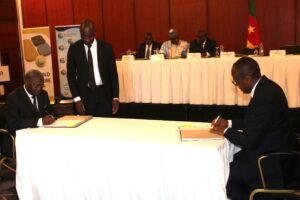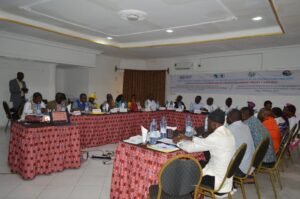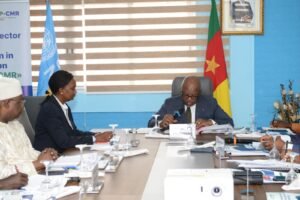The Yaounde Hilton hotel played host on September 20, 2023, to the 4th National Steering Committee meeting of the Regional Stabilization Facility-Cameroon window.

The 4th National Steering Committee Meeting of the Regional Stabilization Facility-Cameroon window held in Yaounde on Wednesday, 20th September 2023 was chaired by the Minister of Economy, Planning and Regional Development, Alamine Ousmane Mey. The key objective of this fourth cometogether was to evaluate the degree of implementation of the project and to develop strategic guidelines for the implementation of upcoming phases.
Added to the main objective, this 4th National Steering Committee meeting of the RSF- Cameroon window was aimed at presenting the principal challenges and constraints, as well as opportunities identified in the implementation of the upcoming Phases of the project.
Apart from the Minister of Economy, Planning and Regional Development who presided at the meeting, it was attended by Aliou Mamadou Dia, Resident Representative of United Nations Development Programme, UNDP in Cameroon, Minister of Basic Education, Laurent Serge Etoundi Ngoa, Minister of Women’s Empowerment and the Family, Marie-Thérèse ABena Ondoa, Minister of Youth Affairs and Civic Education, Mounouna Foutsou, Minister Delegate incharge of Justice, Jean de Dieu Momo, diplomatic representatives and other local authorities.
The Meeting Proper
The Meeting which lasted for close to 3 hours mainly focused on realizations and perspectives as phase II of the RSF-Cameroon window drops curtains to give root to phase III. The localities of Fotokol, Hile-Alifa, Kolofata, Logone-Birni, Makari, Mokolo, and Mozogo are the areas targeted for the second phase.
In his welcome address, UNDP’s Resident Representative, Mr. Aliou Mamadou Dia praised the fruitful and existing collaboration between the government and the United Nations Agency in Cameroon.
In an interview granted to media practitioners, Mr. Aliou Mamadou Dia outlined the fact that more needs to be undertaken in the Far-North region of the country as the third phase of the RSF-Cameroon Window is to be launched in the days ahead. According to UNDP’s patron in Cameroon, the realizations that are underway in some targeted areas of the Far-North region are palpable.
Taking the floor to officially open discussions at the meeting, Minister Alamine Ousmane Mey, set the pace by appreciating the work carried out so far in the first and second phases of the project, which to him are the results of contributive actions of technical and development partners not putting aside authorities which have been very instrumental.
The Minister noted that three key areas have been targeted; the first is the safety and security of the population and their goods, the second is the construction of infrastructures and extending this infrastructure to be able to create the right conducive environment for development and the well-being of people and lastly, the economic empowerment of women, youth through income generating activities.
“I think that all these key areas of action are going to bring back, serenity, and confidence from the people because of the situation they were witnessing. This time around they have very strong confidence in their future. They envisage their development and we want to believe that Cameroon in all its regions is moving towards becoming an emergent country in a very balanced manner. Otherwise, we will not be able to attain our goals in terms of becoming an emergent country” Alamine Ousmane further stated.
After the opening session, a descriptive presentation of activities already carried out during phase II was made by the Head of the Stabilization project, Christophe Charbon. It was disclosed that many different projects have been realized in 7 localities of the Far North region among which are: the rehabilitation of health centers, security, and justice infrastructure built or rehabilitated and equipped as well as education infrastructure built/rehabilitated and equipped.
In his presentation, Mr. Charbon said some of the projects will be completed in August 2024. Yet, he stressed the need for more Gendarmerie Posts to be constructed in a bid to tackle one of their challenges, that of destruction.
The meeting also served as an opportunity for the Youth Affairs and Civic Education Minister to raise some key issues concerning youths of this part of the country. Minister Mounouna Foutsou said young people in these targeted areas need more training opportunities that will help highlight their skills.
On behalf of the Governor of the Far-North region, Nchotu Abraham Tembei, Inspector in charge of deconcentrated technical services said the rate of realizations of phase II has been very concrete and this has already brought great relief to the populations.
Also, during the meeting, Mr. Nchotu expressed the wish for the reconstruction of destroyed homes to be taken into consideration in the drafting of Phase III of the RSF-Cameroon window.
About the Regional Stabilization Facility
The Regional Stabilization Facility (RSF) is a financing facility developed by the United Nations Development Programme (UNDP), with support from Germany, Sweden, the UK, the Netherlands, the European Union (EU), and the African Development Bank (AFDB) to facilitate the implementation of the (RSS of the Lake Chad Basin Region. The facility, which is being implemented in the four affected countries (Cameroon, Chad, Niger, and Nigeria), focuses specifically on four pillars of interventions under the RSS. They include Governance and social Contract; Socio-economic Recovery and Environmental Sustainability; Preventing Violent Extremism and Building Peace and Empowerment and Inclusion of Women and Youth.
The RSF was launched on 18 July 2019 on the margins of the Second Lake Chad Basin Governors’ Forum in Niger. It is a multi-donor basket fund, seeking to mobilize an estimated budget of USD100m to carry out stabilization interventions in the affected territories. The RSF has two types of components; four national windows, providing immediate stabilization (for 18 months) in the specific target areas in the four affected countries, and a regional window that provides extended support for implementing the RSS.
Elise Kenimbeni




